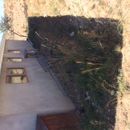Cold climate French drain depth
I built a SIPs house a few years ago. The site is halfway down a gentle slope which is oriented NNW to SSE. The backside of the house faces NNW, and it has a shed roof that drains along the back edge. I want to install a french drain that will keep that side of the house dry. We live in Taos, NM and the other 3 sides of the house are always dry due to the location in the high desert and don’t need any additional drainage. I’m thinking to increase grade from house to trench and increase distance between grade and slab top. Install waterproof membrane (8-10 mil, shown in red). Install french drain with filter fabric and fill entire excavation with 1 1/2″ drainage gravel. Cover the whole works with weed cloth and a layer of sand, then dirt and a shallow rooted ground cover. I think the waterproof membrane is needed due to the Achilles heel of SIPs, wet OSB. Now, I have to remove snow (wheelbarrow time) when the roof slides, which can leave a pile 4′ wide and 3′ tall. I’d like to run the drain to daylight and feed the gutter into it. Spring brings a lot of water seeping down as the ground thaws, so I expect that I’ll have to go below frost line. What slope should the drain run, and is it necessary to put it below frost line to avoid heaving? Is there a better way to do this?
GBA Detail Library
A collection of one thousand construction details organized by climate and house part











Replies
Hi Melissa.
First, and only because you mentioned the grade and the OSB, I want to mention that the grade should not be up against the SIP framed portion of the house at all. But I assume you know that and it is not the case.
Otherwise, I think you have an excellent plan. I have installed French drains in similar situations with much success and I know many people have had success with ground gutters. Though I have never seen it done like this, your combination of the two seems like an elegant solution.
Anyway, the work that I have done has been in a cold climate, and the depth of the drain has been planned based on the water table and the possibility of getting the drain to daylight. I was never told to get the drain below frost depth. I've also fixed French drains and the failure was always that the drain pipe got clogged by soil or crushed because it was too close to grade and driven over.
Oh, thank you, Brian! Grade is below the top of the slab by about 5"-7", but I want it lower, just to be safe. I did occur to me that no matter how deep the drain, once it gets to daylight, an ice plug will form anyway.
Melissa,
Typically, ice plugs do not form in these drains because there is very little flow when the weather is very cold outside. When the weather warms up enough for the snow to melt and the ground is permeable enough for the water to seep in, then the ground is also warm enough to keep the water in the pipe above freezing. Moving, warm water isn't going to freeze quickly enough to form a plug, even if there's a brief period below freezing.
Ice will form on the surface below the drain though, as the water spreads out over frozen ground, so allow for that in your outlet design.
Thanks, Pete! The daylight the drain will run to is just above my garden, where an ice sheet won't pose a problem.
Based on "Spring brings a lot of water seeping down as the ground thaws" and your mention of snow, you may want the final surface grade to be fairly pronounced so as to be capable of handling significant surface flows. In other words, don't completely rely on the 'french' part of the drain to always work when it's needed. (don't worry I'm part French)
If you can afford to detail the finished swale as a broadly sweeping U with decent depth, it will be a more robust feature. Of course you can only sculpt so far into the hill before needing a retaining wall.